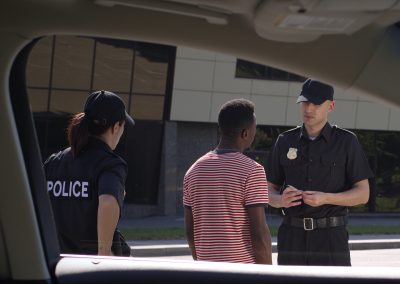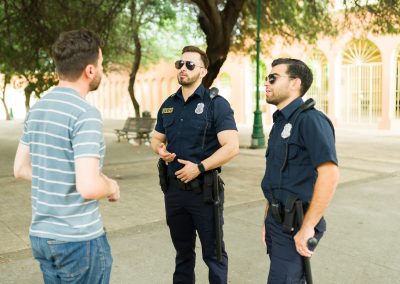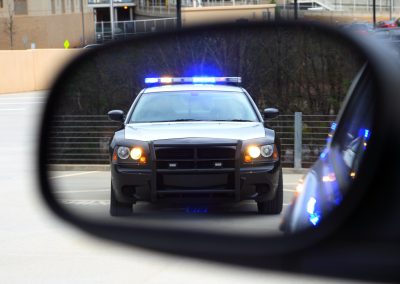It’s a task performed by all motorcycle officers, and some officers have done it so many times that they may not really think about how they do it. Let’s take just a moment and talk about a few issues to consider when you mount and dismount your motorcycle.
Considering It …
Motorcycle officers routinely begin their day by mounting their assigned motorcycle. Whether you’re doing this in your garage or behind your station, do you take the time to tactically plan for this task?
On traffic stops, or when you arrive at an event, you select the best place to park your motorcycle. Now you need to dismount the motorcycle and make contact. Is this task something you think about and plan for? Or is it too routine to require tactical planning? How about when you’ve completed your contact: do you consider a tactical approach to mounting your motorcycle?
Well, I believe mounting and dismounting the motorcycle is a critical task and one that should be taught, planned, and practiced.
Properly Executed
When you approach your parked motorcycle, approach it from the right side. The handlebars should be angled to the left. Grasp the right handlebar with your right hand, balance on your right foot and swing your left leg over the rear of the motorcycle. With both feet firmly on the ground, you can now grasp the left handlebar and straighten out the front wheel. Then, balancing the motorcycle beneath you, use your left foot to retract the side-stand, and you’re ready to go.
Most of the time when you stop your motorcycle behind a violator, you will want to angle the motorcycle away from the curb, pointing it slightly back out toward the traffic lane. This way, if the violator accidentally—or intentionally—begins to back up while you are still on your motorcycle you have the option to accelerate and escape.
Normally, you would want to place the motorcycle on its side-stand by extending the side-stand with your left foot. Turn your handlebars to the left, curling the motorcycle around the side-stand. Curling the motorcycle around the side-stand, especially on off-camber surfaces, helps to keep the motorcycle leaning on the side-stand. Then, stand up on your right foot, release your left hand, and rotate your body to the left, swinging your left leg over the rear of the motorcycle.
These maneuvers accomplish several critical points for you.
- You are able to mount and dismount the motorcycle on the “high side,” away from the side-stand. If the side-stand were to fail, or it was not completely down and locked, the motorcycle will fall away from you and not on you.
- You have dismounted the motorcycle and positioned yourself away from the traffic lane, leaving the motorcycle between you and passing traffic. You are also in position to glance back at oncoming traffic before mounting the motorcycle from the high side.
- You can easily accomplish this maneuver while keeping your eyes on the violator and the violator’s vehicle. In this position, you will be facing the roadway, needing only a slight turn of your head to check oncoming traffic.
- Dismounting the motorcycle on the “high side” also places you on the right side of the violator’s vehicle, setting you up for a right side approach.
In many instances, mounting and dismounting the motorcycle on the “low side,” or left side, places your back right up against the traffic lane. On a narrow roadway, you may find your back is in the traffic lane—not where you want to be.
Other Considerations
Of course, there are exceptions to every rule. There are times when you may find the need to mount or dismount your motorcycle on the “low side.” If, for some reason, you are making a contact in the center divider or the middle lanes of a roadway, then a “low side” dismount may be appropriate to keep yourself away from traffic. If you find yourself contacting a group of people who may be hostile toward you, you would want to mount and dismount on whichever side that keeps you from turning your back on the group and places your motorcycle between you and the group.
Other instances of breaking the “high side” rule may include when you have committed to your stop and come under fire. The motorcycle may provide you with a limited amount of cover and concealment. In this case, dismounting the motorcycle on the side away from your attacker is obviously best.
Typically, the engine of the motorcycle, although small in physical size, will provide you with the most cover. You may want to consider allowing the motorcycle to fall onto its side, away from you, to provide cover and concealment. You can then return fire from a prone position. You may also find the best cover and concealment is to get away from the motorcycle on foot, especially during darkness.
If you have a long gun mounted on your motorcycle, consider how best to utilize this tool when you are confronted with an armed attacker. Regular scenario-based training on deploying with the long gun should be included along with on-going motorcycle skill development training.
Conclusion
In any event, the routine of mounting and dismounting the motorcycle should be anything but routine. It is a task that you will perform many times throughout your day, and one that can place you in peril, or give you a tactical advantage. Stay safe.










0 Comments